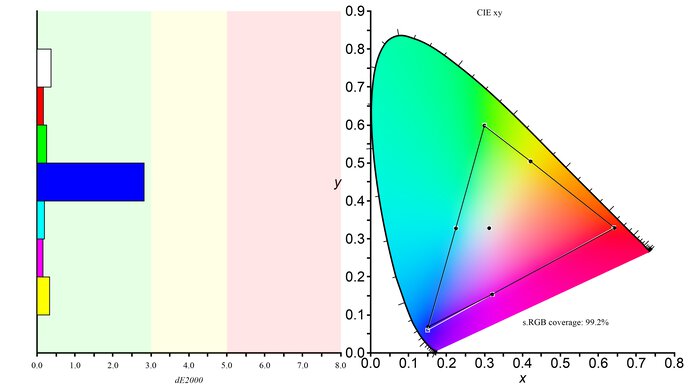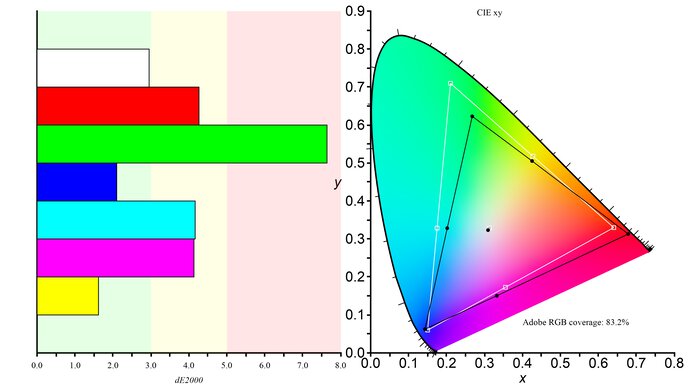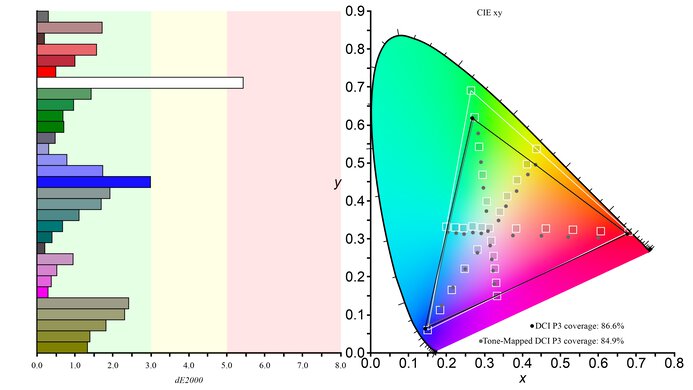The Samsung Odyssey G7 S28AG70 is the first 4k monitor in Samsung's Odyssey gaming lineup. It has a 144Hz refresh rate with HDMI 2.1 inputs, meaning you can achieve its max refresh rate with a 4k resolution over both DisplayPort and HDMI connections. The two HDMI 2.1 inputs support 4k @ 120Hz gaming from the Xbox Series X, PS5, or PCs. There's native FreeSync variable refresh rate (VRR) support, and it's certified by NVIDIA to be G-SYNC compatible. It's different from the Samsung Odyssey G7 C32G75T because it has a flat screen, and it has an IPS panel with wide viewing angles, which also means it has a low contrast ratio that makes blacks look gray.
Our Verdict
The Samsung G70A is great for most uses. It's excellent for gaming because it has fantastic motion handling, low input lag, and a 144Hz refresh rate with HDMI 2.1 inputs. It's also great for content creators, office use, or consuming multimedia content because its 4k resolution produces sharp text, and the wide viewing angles result in an accurate image when viewing from the sides. It's decent for HDR gaming, but sadly it has a low contrast ratio and terrible local dimming that deliver a bad dark room experience.
- 4k resolution delivers sharp images.
- Wide viewing angles.
- 144Hz refresh rate with HDMI 2.1 inputs.
- Fantastic motion handling.
The Samsung G70A is a great office monitor. It has a large 28 inch screen with a high 4k resolution for exceptional text clarity and sharp images. It has wide viewing angles, making it a good choice if you need to share the screen with a coworker, and the ergonomics are great, but the swivel range is narrow. Also, it gets bright enough to fight glare in most rooms, but its reflection handling is just decent.
- 4k resolution delivers sharp images.
- Wide viewing angles.
- Bright enough to fight glare in most rooms.
- Narrow swivel range.
- Only decent reflection handling.
The Samsung G70A is excellent for gaming. It has a fast 144Hz refresh rate, and you can reach its max refresh rate with a 4k resolution over an HDMI connection because it has two HDMI 2.1 inputs. It has native FreeSync support, G-SYNC compatibility to reduce screen tearing, and motion looks smooth thanks to the quick response time. Unfortunately, it's not a good choice for dark room gaming because it has a low contrast ratio.
- Wide viewing angles.
- 144Hz refresh rate with HDMI 2.1 inputs.
- FreeSync support and G-SYNC compatibility.
- Fantastic motion handling.
- Low contrast ratio and terrible local dimming feature.
The Samsung Odyssey G70A is good for consuming multimedia content. Its 4k resolution allows you to watch the latest high-resolution videos, and it has wide viewing angles if you want to share the screen with a few friends. It also has great ergonomics, but its swivel range is fairly narrow. Also, its dark room performance is bad because it has low contrast, and the edge-lit local dimming feature is terrible.
- 4k resolution delivers sharp images.
- Wide viewing angles.
- Bright enough to fight glare in most rooms.
- Narrow swivel range.
- Only decent reflection handling.
- Low contrast ratio and terrible local dimming feature.
The Samsung G70A is great for content creators. The 4k resolution and 28 inch screen help deliver clear images and sharp text. The wide viewing angles make it easy to share your screen with a client, but it has a narrow swivel range, so it's harder to turn the screen. It also has good out-of-the-box accuracy, exceptional gradient handling, and a fantastic SDR color volume, so colors appear as they should while editing.
- 4k resolution delivers sharp images.
- Wide viewing angles.
- Bright enough to fight glare in most rooms.
- Narrow swivel range.
- Only decent reflection handling.
- Low contrast ratio and terrible local dimming feature.
- Mediocre HDR peak brightness.
Changelog
- Updated Jul 11, 2024: Changed the Ergonomics score and updated the text, as the previous tilt range and ergonomics scores were incorrect.
- Updated Apr 18, 2023: Confirmed that 1440p @ 60Hz works on this monitor with the PS5.
- Updated Jan 24, 2023: Compared this monitor's SDR Brightness to that of the recently-reviewed Samsung Odyssey G7/G70B S32BG70, which gets brighter.
- Updated Jul 27, 2022: We added text to the Xbox Series S|X section of the review to clarify a few issues using this monitor with those consoles.
Check Price
Differences Between Sizes And Variants
We tested the 28 inch Samsung Odyssey G70A, which is a new monitor in Samsung's Odyssey lineup. It indirectly replaces the Samsung Odyssey G7 C32G75T from 2020, although that Odyssey G7 is a completely different monitor, and Samsung is still selling it. You can see the differences between them below. The G70A is part of the 2021 Odyssey lineup, sitting above the Samsung Odyssey G5 S27AG50.
| Name | Size(s) | Short Model Code | US Model | Refresh Rate | Resolution | Panel Type | Curve |
|---|---|---|---|---|---|---|---|
| Odyssey G75T | 27", 32" | C27G75T/ C32G75T |
LC27G75TQSNXZA/ LC32G75TQSNXZA |
240Hz | 2560x1440 | VA | Yes |
| Odyssey G70A | 28" | S28AG70 | LS28AG700NNXZA | 144Hz | 3840X2160 | IPS | No |
If someone comes across a different type of panel or if their G70A doesn't correspond to our review, let us know, and we'll update the review. Note that some tests, like gray uniformity, may vary between units.
Our unit of the Samsung Odyssey G7 28 was manufactured in June 2021; you can see the label here.
Popular Monitor Comparisons
The Samsung G70A is an excellent gaming monitor. It has fantastic motion handling, low input lag, and VRR support, and the HDMI 2.1 inputs make it a worthwhile choice if you have an Xbox Series X. However, if you have a PS5, you need to make sure you can update the firmware to get 4k @ 120Hz gaming. It's a downgrade compared to the Samsung Odyssey G7 C32G75T in dark room performance, but it has wider viewing angles instead.
Also see our recommendations for the best 4k gaming monitors, the best Samsung monitors, and the best 32-inch monitors.
In name, the Samsung Odyssey G7 S28AG70 is an updated version of the Samsung Odyssey G7 C32G75T, but they're different types of monitors. The S28AG70 is a flat 4k monitor with a 28-inch screen, while the C32G75T is a curved 1440p model available in 27 and 32 inches. The S28AG70 has an IPS panel with wide viewing angles, and the C32G75T has a VA panel with better contrast. In terms of picture quality, the C32G75T is better in a few areas as it gets brighter and has better reflection handling, and even though it has a quicker overall response time, the S28AG70 has better motion handling because there's less black smearing.
The Samsung Odyssey G7/G70B S32BG70 is the newer version of the Samsung Odyssey G7 S28AG70 with many of the same features and performance. The BG70 is available in 28- and 32-inch screen sizes, while the AG70 is available in just a 28-inch screen size. The BG70 improves in a few areas, like peak brightness, reflection handling, and motion handling. It also has a built-in Tizen OS smart platform, which the AG70 doesn't have, letting you stream content without a PC.
The Samsung Odyssey G7 S28AG70 and the Samsung Odyssey Neo G8 S32BG85 are different types of 4k gaming monitors. They have different panel types with strengths and weaknesses, as the Neo G8 delivers deeper blacks while the G7 has wider viewing angles. The Neo G8 also has a higher 240Hz refresh rate and delivers a better HDR experience as it gets brighter.
The Gigabyte M28U and the Samsung Odyssey G7 S28AG70 are two excellent 4k gaming monitors. Picture quality is fairly similar, and even though the Gigabyte has much better out-of-the-box accuracy, it may vary between units. Motion is fantastic on each, but the backlight strobing feature on the Gigabyte flickers at a wider range than the one on the Samsung. They both have HDMI 2.1 inputs, but the Samsung has 40 Gbps bandwidth while the Gigabyte is limited to 24 Gbps, so it needs Display Stream Compression for certain signals, which you won't have to worry about on the Samsung.

We buy and test more than 30 monitors each year, with units that we buy completely on our own, without any cherry-picked units or samples. We put a lot into each unbiased, straight-to-the-point review, and there's a whole process from purchasing to publishing, involving multiple teams and people. We do more than just use the monitor for a week; we use specialized and custom tools to measure various aspects with objective data-based results. We also consider multiple factors before making any recommendations, including the monitor's cost, its performance against the competition, and whether or not it's easy to find.
Test Results

The Samsung G70A has a very different design than the Samsung Odyssey G7 C32G75T. It has a flat screen with thin bezels on three sides and a thicker bottom bezel that features RGB lighting. It has a heavy gaming-oriented design that makes it ideal for a gaming setup, and it would stick out in an office environment.
The Samsung Odyssey G7 28 has decent build quality, but it's disappointing for a high-end monitor, and it doesn't feel as well-built as the Samsung Odyssey G7 C32G75T. The plastic on the back feels cheap and flexes throughout. The cover to the RGB lighting also feels flimsy, and the stand doesn't support the screen well.
The ergonomics are great. You get all the common ergonomic adjustments, but the swivel range is limited. Also, you can only rotate it into portrait mode one way, so the inputs will always face to the left. The back of the Samsung G70A looks almost exactly like the Samsung Odyssey G7 C32G75T. The plastic panel is a bit glossy with etched lines, and there's a ring of RGB lighting. You can route cables through the rubber clip on the stand for cable management. There's also a slot for a Kensington lock on the back right side.
The stand has two legs that sit flat against the table, but without much support in the back, the screen wobbles easily. The stand doesn't take up too much space, which is good, and there's enough room between the legs to place objects in front, like your keyboard and mouse.
The Samsung G70A has an IPS panel with a low native contrast ratio. The local dimming feature doesn't do much to improve it because our checkerboard pattern turns all the zones on. Also, the local dimming locks the brightness at its max, while we normally measure the contrast at 100 nits. Contrast can vary a bit between units, but we don't expect it to be much higher for an IPS panel.
The Samsung Odyssey G7 28 has a terrible edge-lit local dimming feature. It only has 8 dimming zones, which are large, and the entire zone turns on when there's a small bright highlight. It results in distracting blooming, and it's obvious when highlights transition between the zones. Even subtitles look terrible because it lights up everything around them. In scenes like a star field, it won't turn on the zones if there are only a handful of small highlights, but all the zones light up if there are more bright objects, at which point the contrast looks bad.
We tested it with the Local Dimming setting at 'On'. There's also an 'Auto' option that turns on the local dimming when you enable HDR, and it disables it with SDR. Enabling the Local Dimming adjusts the brightness to the max, even if you set the Brightness setting lower, it doesn't do anything.
Samsung released another 4k monitor, the Samsung Odyssey Neo G7 S32BG75, that features Mini LED backlighting with a much better local dimming feature.
The Samsung Odyssey G7 28's SDR peak brightness is good. It gets bright enough to fight glare in most settings, but it's a bit inconsistent across different scenes. Still, it won't be an issue for most people. We measured it in the 'Custom' Picture Mode after calibration with Brightness at '100' and Local Dimming at its max.
We also measured the brightness in the 'High Bright' Picture Mode before calibration, which has a slightly brighter image at the cost of image accuracy, and the gamma is terrible. You can see the results below:
- Real Scene: 319 cd/m²
- Peak 2% Window: 404 cd/m²
- Peak 10% Window: 415 cd/m²
- Peak 25% Window: 401 cd/m²
- Peak 50% Window: 386 cd/m²
- Peak 100% Window: 350 cd/m²
- Sustained 2% Window: 401 cd/m²
- Sustained 10% Window: 413 cd/m²
- Sustained 25% Window: 400 cd/m²
- Sustained 50% Window: 385 cd/m²
- Sustained 100% Window: 350 cd/m²
If you care about peak brightness and also want an accurate image, the Samsung Odyssey G7/G70B S32BG70 gets brighter and has better color accuracy.
The Samsung G70A has mediocre HDR peak brightness. It barely meets its brightness requirement for the VESA DisplayHDR 400 certification, and it doesn't get bright enough to make highlights stand out. It's worse than the Samsung Odyssey G7 C32G75T. We also checked the EOTF, which affects the brightness level of different scenes, and it doesn't follow the target PQ curve well because dark scenes are too dark, and bright scenes are over-brightened until the sharp roll-off, so you lose details in the brightest highlights.
We tested it in the 'HDR Dynamic' Picture Mode with Local Dimming enabled.
We also checked the brightness of the 'HDR Standard' mode. It's dimmer than 'HDR Dynamic', and has a worse EOTF as all scenes are too dim. You can see the results below:
- Real Scene: 287 cd/m²
- Peak 2% Window: 360 cd/m²
- Peak 10% Window: 372 cd/m²
- Peak 25% Window: 344 cd/m²
- Peak 50% Window: 346 cd/m²
- Peak 100% Window: 315 cd/m²
- Sustained 2% Window: 358 cd/m²
- Sustained 10% Window: 370 cd/m²
- Sustained 25% Window: 344 cd/m²
- Sustained 50% Window: 345 cd/m²
- Sustained 100% Window: 314 cd/m²
Like other IPS panels, the Samsung Odyssey G7 28 has wide horizontal viewing angles. The image remains accurate as you move off the side, which is great for sharing your screen with someone, like during co-op gaming.
The Samsung Odyssey G7 28 has good vertical viewing angles. Once again, you don't lose much image accuracy if you're viewing the screen from above or below.
The Samsung Odyssey G7 28 has disappointing black uniformity. Without local dimming, the entire screen looks gray due to the low contrast, but the screen itself is fairly uniform. The local dimming feature worsens the uniformity because there's more blooming around the center cross. Since the local dimming locks the brightness to the max, we measured it at its max brightness instead of the 100 nits we normally aim for.
The out-of-the-box accuracy on our unit of the Samsung Odyssey G7 28 is good. The color temperature is close to the 6500K target, and the white balance is only a bit off. However, colors are more inaccurate, especially the primaries that are over-saturated. Gamma also seems to follow a flat 2.2 target instead, so some dark scenes are too dark, while brighter scenes are over-brightened. If you care about out-of-the-box accuracy, the Dell G3223Q is a great alternative.
After calibration, the accuracy is exceptional. Any remaining accuracies to the white balance and colors aren't visible to the naked eye, and gamma improved, but it's still not perfect.
The Samsung G70A has a fantastic SDR color gamut. It has full coverage of the sRGB color space used in most SDR content, and it has great coverage of the Adobe RGB color space, but it still may not be ideal for professional photo editors.
The Samsung Odyssey G70A has an exceptional SDR color volume. Thanks to its high peak brightness and wide color gamut, it displays bright colors well but struggles with darker colors due to the low contrast.
The Samsung G70A has a good HDR color gamut, with excellent coverage of the DCI P3 color space. However, it has limited coverage of the wider Rec. 2020 color space, and tone mapping is off for both, so most colors are inaccurate.
The Samsung Odyssey G7 28 has decent reflection handling, but it's worse than the Samsung Odyssey G7 C32G75T because light scatters more across the screen. Combined with its good peak brightness, glare won't be an issue with a few lights around, but you'll struggle to see the screen if you place it opposite a bright window.
The Samsung Odyssey G7 28 has a high 144Hz refresh rate, which you can achieve both over DisplayPort and HDMI thanks to the HDMI 2.1 inputs. FreeSync works over the entire range with both connections, but the G-SYNC compatibility only works over DisplayPort; over HDMI, the NVIDIA Control Panel recognizes it, but we couldn't enable G-SYNC in the pendulum demo. Let us know if it works on your unit.
| Overdrive Setting | Response Time Chart | Response Time Tables | Motion Blur Photo |
| Standard | Chart | Table | Photo |
| Faster | Chart | Table | Photo |
| Extreme | Chart | Table | Photo |
| VRR | Chart | Table | Photo |
The Samsung G70A has an incredible response time at its max refresh rate of 144Hz. Motion looks smooth with minimal overshoot in most transitions. We recommend enabling the VRR setting, called Adaptive Sync because it performs almost exactly like the 'Standard' Response Time setting, and enabling VRR locks the Response Time setting and you can't change it anyways.
| Overdrive Setting | Response Time Chart | Response Time Tables | Motion Blur Photo |
| Standard | Chart | Table | Photo |
| Faster | Chart | Table | Photo |
| Extreme | Chart | Table | Photo |
| VRR | Chart | Table | Photo |
The Samsung Odyssey G70A has an impressive response time at 60Hz, but motion looks worse than its max refresh rate because there's more overshoot, resulting in some ghosting. Once again, we suggest simply enabling VRR to have the best motion handling possible, but if you don't use VRR, set the Response Time to 'Standard.'
| Refresh Rate | BFI Setting | Motion Blur Photo |
| 144Hz | On | Photo |
| 120Hz | On | Photo |
| 60Hz | On | Photo |
The Samsung Odyssey G7 28 has an optional backlight strobing feature, commonly known as black frame insertion. It only flickers within a narrow range, and you can't use it at the same time as VRR. There's a setting to enable it at 60Hz, but it still flickers at 120Hz, as you can see in this photo.
The Samsung Odyssey G7 28 has a completely flicker-free backlight at all brightness levels, which helps reduce eye strain. We didn't notice any flicker issues like with the Samsung Odyssey G7 C32G75T.
The Samsung G70A has low input lag for a responsive gaming experience. The input lag remains low when you're gaming at 60Hz, but like the Samsung Odyssey Neo G9/G95NA S49AG95, you have to enable VRR or make sure the refresh rate on the monitor matches the refresh rate of your PC to get the lowest input lag possible. With the monitor's refresh rate set to 144Hz and the PC's refresh rate at 60Hz, we measured an input lag of 26.8 ms.
The high 4k resolution on the Samsung Odyssey G70A helps deliver clear images and crisp text.
The Samsung Odyssey G7 S28AG70 is fully compatible with nearly all features of the PS5, but it doesn't support 1440p @ 120Hz. Although 4k @ 120Hz once required the monitor to be in 'AV' Mode, that's no longer the case, as the PS5 also supports 4k @ 120Hz with HDR and VRR enabled in 'PC' Mode.
The Samsung Odyssey G7 S28AG70 is nearly fully compatible with the Xbox Series S|X, but there are a few quirks. The variable refresh rate feature only works if the monitor is in 'PC' mode, but in 'PC' mode, 1440p @ 120Hz doesn't work. That format works fine in 'AV' mode, but disables 1080p @ 120Hz, and adaptive sync doesn't work. In short, you have to choose between adaptive sync support and 1440p @ 120Hz support; you can't enable them at the same time.
The Samsung G70A has two HDMI 2.1 inputs that support 40 Gbps bandwidth instead of the max 48 Gbps, as you can see here, but this isn't an issue as you can still achieve 4k @ 120Hz signals in 10-bit HDR with chroma 4:4:4.
This monitor works fine with recent MacBooks for the most part, but there are some issues with the gaming features. VRR flickers at lower framerates, but HDR doesn't work unless you set the Refresh Rate setting on the monitor to "120", so it's not possible to use HDR and VRR at the same time. On the other hand, there are no issues putting the computer to sleep or closing the lid.
There are a few additional features on the Samsung S28AG700, including:
- Black Stabilizer: Adjusts the gamma so that you see opponents in shadows of games.
- Core Sync Lighting: Matches the RGB lighting to the content on the screen, but there's a big delay so it's distracting to use.
- Crosshair: Adds a virtual crosshair on the screen that your PC won't detect.
- Frame Rate Counter: Displays the frame rate of your signal.
If you want a 4k display from Samsung that has a built-in smart system, then check out the Samsung Smart Monitor M8 S32BM80.






















































